#and Hecate was with Demeter during her journey in search of her daughter
Text
Hermes: The biggest waste potential is that Persephone has three moms but I can't pull "yo mama" jokes on her.
Hermes: I mean, I can, but I don't wanna lose my balls by her sickle.
#hermes#persephone#demeter x hecate#demeter x leto#leto x demeter x hecate#incorrect greek mythology#incorrect greek mythology quote#incorrect greek gods#fun fact: Artemis and Persephone are said to raised together as children#so that means they have two moms (Leto and Demeter)#and Hecate was with Demeter during her journey in search of her daughter#so in this essay i will explain why Leto x Demeter x Hecate is canon in Greek mythology-
89 notes
·
View notes
Text
Hekate's Torchlight at Sacred Eleusis.
Among the mystery cults of ancient Greece, none were as influential as the Eleusinian Mysteries celebrated in the town of Eleusis , the mysteries of Eleusis were dedicated to Demeter and her daughter Persephone. And while many aspects of the Mysteries are lost to time due to the strict vow of secrecy initiates of the Mysteries would undergo. it is known that the most central element of the mysteries was the abduction Personal by Hades, as depicted in The Homeric Hymn to Demeter. Persephone's role as queen of the underworld and her eventual return to the surface, aspects which were symbolic of the cycle of life, death, and rebirth. And while Demeter and Persephone were the central figures associated with Sacred Eleusis. They were not the only ones. Hekate, Goddess of Crossroads and witchcraft also played an integral role in the Mysteries. As told in the Homeric Hymn to Demeter.
"...only tender-hearted Hecate, bright-coiffed, the daughter of Persaeus, heard the girl from her cave...But when the tenth enlightening dawn had come, Hecate, with a torch in her hands, met her, and spoke to her and told her news:
“Queenly Demeter, bringer of seasons and giver of good gifts, what god of heaven or what mortal man has rapt away Persephone and pierced with sorrow your dear heart? For I heard her voice, yet saw not with my eyes who it was. But I tell you truly and shortly all I know." So, then, said Hecate. And the daughter of rich-haired Rhea answered her not, but sped swiftly with her, holding flaming torches in her hands..."¹
When Persephone was taken by Hades, it was Hekate, with her torches casting light into the darkness, who joined Demeter in her search for her daughter. This, combined with her role as a Goddess who could traverse the boundaries of the world, Hekate became a guide and mediator between the realms of the living and the dead. A role she would carry out as part of her role in the Mysteries.
Additionally, the inclusion of Hekate in the Mysteries is emblematic of her broader role as a deity of transitions and transformations. Initiates of the Mysteries, known as 'mystai', underwent a series of rites and ceremonies, and while the details of said rites has been lost to time. It is believed that these rites were meant to guide the participants through a spiritual death and rebirth, mirroring the descent and ascent of Persephone.
What we do know of these rites speaks to this with the consumption of a sacred drink known as Kykeon towards the end of the initiation process itself. Kykeon which translates to "mixture" in Greek was a concoction of water, barley and herbs and in the context of the Mysteries a psychoactive substance to induce altered states of consciousness as part of this spiritual death and rebirth. Hekate's presence in these rites likely served as a comforting and protective influence during the initiates' symbolic journey through darkness and uncertainty, Hekate in her role as propolos was both a guide and a guardian, her torches illuminating the path through the underworld the mystai had to navigate to emerge enlightened and reborn a new.
In conclusion, Hekate played a major role in the Cult of Demeter at Eleusis. Her torches, symbols of illumination and protection, guided the initiates through their spiritual journey, Just as Hekate stood at the crossroads, the Mysteries themselves were a spiritual crossroads for the participants, a place where death and rebirth were intimately entwined, and where the torchlight of Hekate illuminated the sacred path of transformation. While the mysteries of Eleusis may remain largely concealed, the presence of Hekate within them is a beacon that continues to intrigue and inspire those who seek to understand the profound wisdom of the ancient world.
¹: Homeric Hymn to Demeter translated by Hugh Evelyn-White
4 notes
·
View notes
Text
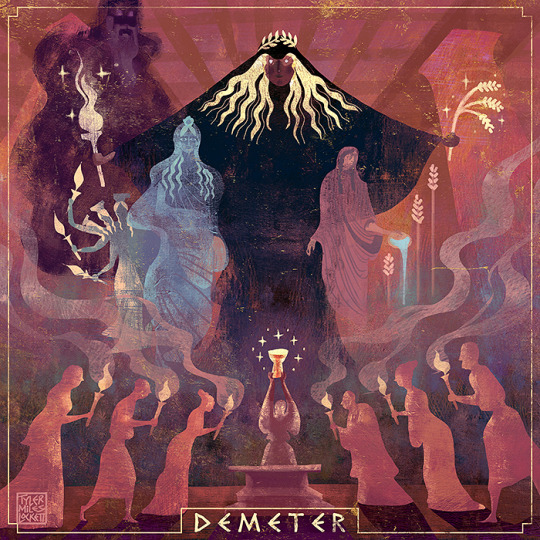
The Cult of Eleusis had a bi-annual rituals; in the spring "the lesser mysteries" in the fall. "the greater mysteries", for over 2000 years, where all citizens (royalty and slaves alike) would make a pilgrimage to Eleusis to partake in a festival and initiation ritual tied to the myth of Demeter and her daughter's kidnap by Hades into the underworld. This festival and ceremony would essentially initiate you, provide some spiritual insight, thereby guaranteeing a better position in the afterlife. (similar to a baptism guaranteeing a position in heaven, perhaps.) Only those who had committed murder or who could not speak greek were refused to participate.
Citizens would make the 15 mile walk from Athens, all the while being shouted profanities upon by onlookers, to break down their egos. Unfortunately, as the crime of revealing the inner ceremony of the mysteries would be punishable by death, we can't know for sure what took place in the inner sanctum during the main ceremony. What we do know is that something was drunk and something was "seen". Many believe that the drink offered to initiates, the KYKEON, would produce a psychotropic, hallucinatory effect. (perhaps tainted with ergot (rotten barley fungis), or maybe mushrooms.) Apparently the ritual had 3 stages (mirroring Persphones underworld journey) the descent, the search, and the ascent. Some believe the final act shown to the initiate was the cutting of an ear of grain, to symbolize the cyclical death and rebirth of nature.
I drew Demeter holding her torch she uses to search for her missing daughter, and an ear of wheat grain to symbolize her role in agriculture. to the left we have the main players of the lost daughter myth. Hades behind, and Persephone in front, with Hecate beside, who helped Demeter find her daughter, and became Persephone's attendant in Tartarus. On the right we have a woman pouring libations to help the wheat grow, then Demeter holding the cut grain.
#greekmyth#greekmythology#digital fanart#digital art#pjo#percy jackon and the olympians#percy jackson#greekgod#greek myth moodboard#persephone#tartarus#underworld#percy jackson fanart#hades#demeter#cult of eleusis#eleusis#pluto#ceres#mystery cult#hecate#tagamemnon#mythology tag#hellenic#hellenic pagan#hellenic pantheon#hellenic community#hellenism#hellenist#hellenic polytheism
789 notes
·
View notes
Text
Persephone: Goddess Correspondences, Symbols & Myth

Persephone is the Queen of the Underworld in Greek mythology. Daughter of Demeter (Mother Earth) and Zeus (King of Olympus), she keeps the secrets of the dead and was known among the Romans as Proserpina.
The myth of Persephone is traditionally told around Samhain by Neopagans, and is also popular in mainstream society. Persephone and her mother Demeter (Goddess of the fertility of the Earth) represent Nature, with its powers of transformation and its cycles.
Working with Goddess Persephone
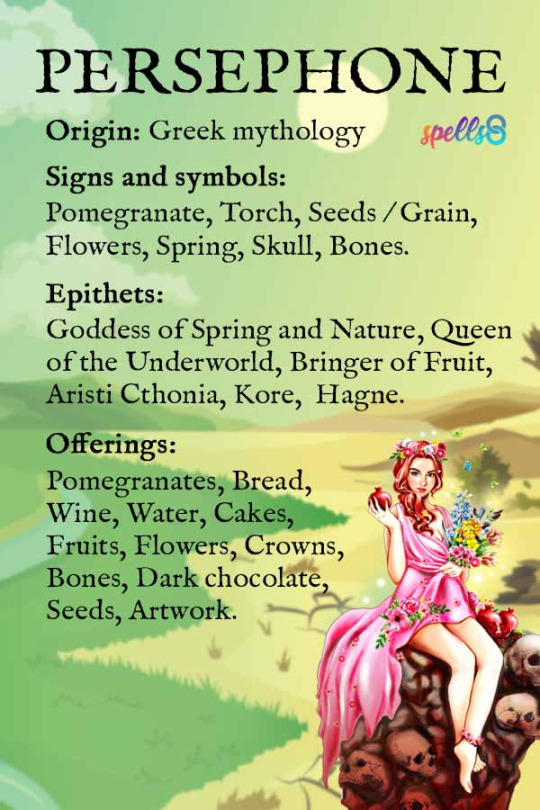
Goddess Persephone Correspondences
Persephone is also called ‘Kore,’ which means both ‘daughter’ and ‘maiden’ in Greek. Kore is her name as a vegetation goddess. According to the Eleusinian Mysteries, Persephone divided her time between Earth and Hades, acting as Goddess of grain and Queen of the Underworld for each half of the year.
The Eleusinian Mysteries were the secret re-enactment of this myth which occured once a year in Eleusis, Greece. Followers of the cult of Demeter and Persephone celebrated in a religious festival which led its initiates through a symbolic life, death, and rebirth. For the initiated, the rebirth of Persephone symbolized the eternity of life which flows from generation to generation, and they believed that they would have a reward in the afterlife.
Mythology
Symbols of Persephone
Persephone as Triple Goddess
Titles and Epithets of Persephone
Signs of Persephone
How to Worship Persephone
Further reading
Goddess Persephone Correspondences
Offerings to Persephone
Invocations & Prayers
Myth of Persephone
The young Kore (Persephone), daughter of vegetation Goddess Demeter, was picking flowers by the lakeside. Suddenly, the earth beneath her cracked open and a chariot pulled by black horses surfaced. Hades appeared and forcefully decided to take Kore to live with him in the Underworld. Her name changed to Persephone and she became Queen of the Underworld. Demeter began long and sad journeys in search of her beloved daughter, during which the land became barren.
Demeter went to see Helios and asked if he knew what happened to his daughter. He confessed that she had been kidnapped by Hades. She then turned to Zeus, who sent Hermes (in some versions, Hecate) down to the Underworld and retrieve his daughter. Zeus had promised that Persephone would be restored, provided she had not yet tasted anything in hell. Hermes went and ordered Hades to return Demeter’s daughter. Before she let her go, Hades gave her a pomegranate, of which Persephone ate six seeds.

Hermes helping Persephone to return to her mother Demeter
The fact that Persephone had eaten a fruit from the Underworld meant she was confined to remain there. Eventually, an agreement was made; Persephone would spend six months in the Underworld, one month for each seed she ate, which would correspond to the seasons of fall and winter, and the rest of the year she could live on the surface with her mother, which would correspond to spring and summer.
The myth provided an explanation for the changing of the seasons. The Eleusinian Mysteries were a yearly festival which represented the myth of the abduction of Persephone from her mother, in a cycle with three phases: the descent (loss), the search, and the ascent, with the main theme being the ascent of Persephone and the reunion with her mother, symbolizing death, regeneration, and the immortality of nature.
Symbols of Persephone
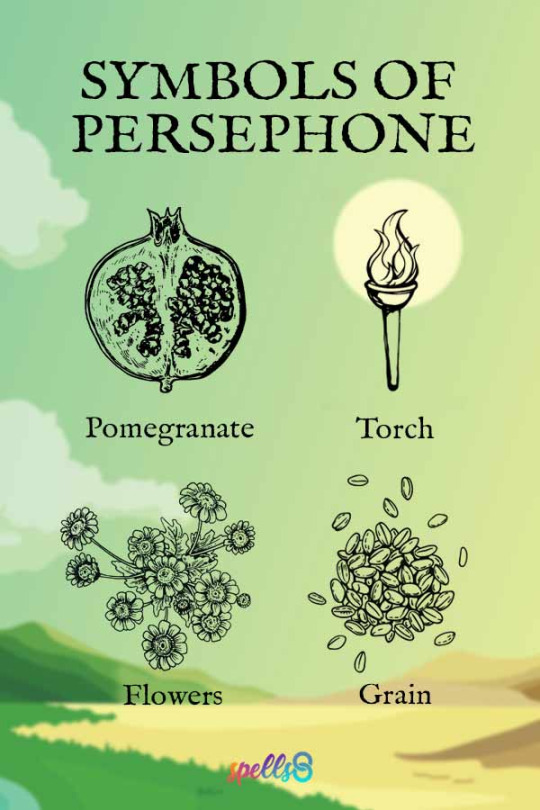
Pomegranate: The pomegranate is a symbol for life and abundance, but also for death. The many seeds in the fruit represent the capacity for new life and new growth. However, pomegranates appear to bleed when cut, and this symbolizes the link of Persephone with the world of the dead. The pomegranate is a symbol of fidelity in marriage and, in the myth of Persephone, it chained her to her life with Hades, representing her captivity too.
Torch: In Persephone’s myth, Demeter spent days wandering the earth with a flaming torch in each hand searching everywhere for her missing daughter. The torch symbolizes her eternal vigilance and her tirelessness illuminating the way back from the Underworld, or the regeneration of life in spring.
Seeds of grain: Persephone is the embodiment of spring and a personification of vegetation, especially grain crops, which disappear into the earth when sown, sprout from the earth in spring, and are harvested when fully grown. Likewise, Persephone dies as she stays in the Underworld and is reborn when she comes back to earth in the spring.
Flowers: Not only was Persephone picking flowers when she was abducted, but also flowers were associated with birth and life after death. Flowers are a main symbol of the return of spring after winter.
Persephone as Triple Goddess
Ancient Greek poets left us the concept of “ancient triad” in which a deity is worshiped as three. In Plato’s Symposium, the Goddess Demeter is a triad made of Kore, Persephone, and Hecate.
Wiccan views of the Goddess usually include a similar archetype of Maiden, Mother, and Crone. The archetype has many possible interpretations but it generally references three stages of human life, in connection with never-ending cycles of transformation.
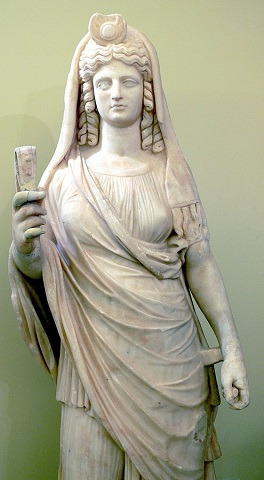
Persephone reflects the cycle of life, death, and rebirth; spring occurs when Persephone returns from the land of the dead and winter begins when Persephone must go back to the underworld, six months later.
In the religions of the Orphics and the Platonists, Kore is described as the all-pervading goddess of nature who both produces and destroys everything, and she is therefore mentioned along with or identified as other such divinities including Isis, Rhea, Gaia, Hestia, Pandora, Artemis, and Hecate.
In the Rider-Waite Tarot deck, we see a reference to Persephone in the High Priestess card. She sits in Solomon’s temple between the pillars of wisdom, with pomegranate trees growing behind her.

High Priestess Tarot card
Titles and Epithets of Persephone
Due to Persephone’s complexity, she has been given many names and titles. Some of these names at titles are as followed:
Goddess of Spring and Nature – Persephone moves between the earth and the underworld representing immortality. She rules over the living and death, just as nature does.
Queen of the Underworld – Persephone’s marriage to Hades grants her authority over the realm of the dead.
Hagne – meaning pure or goddess of springs.
Aristi Cthonia – “the best chthonic”, or deities and spirits of the underworld.
Kore – the maiden.
Kore Memagmeni – The mixed daughter.
Karophoroi – The bringer of fruit.
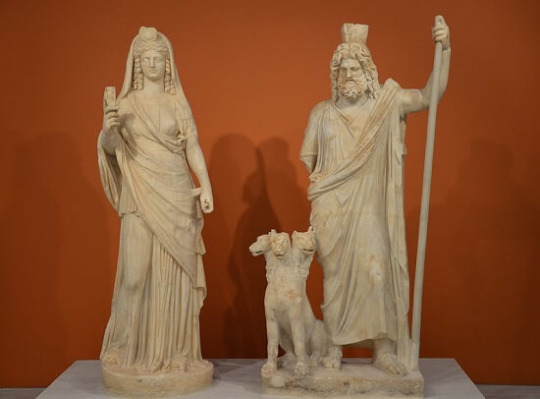
Statue of Persephone and Hades
Signs of Persephone
Many myths and archetypes such as Demeter-Persephone remain latent in the collective unconscious and sometimes jump to people’s consciousness in times of crisis and change. Deities may approach us in different ways, whether as archetypes or as real entities. It’s different for everyone.
As a Queen of the Underworld, Persephone understands trauma, loss, shadow, mental illness, anguish, pain, and cold. She sees beyond the veil, far past what most are unaware of. Working with her can help you uncover the darkest aspects of yourself and life, helping empower you into a much better version of yourself.
You don’t need any special signs or “calling” to worship a God or Goddess. If you feel a connection to Persephone or if you have a special interest in her, start your worship by reading the mythology and learning more about her.
Meditate upon the image of Persephone and let her voice, touch, and thoughts embrace you. Listen to her and talk to her.
How to Worship Persephone
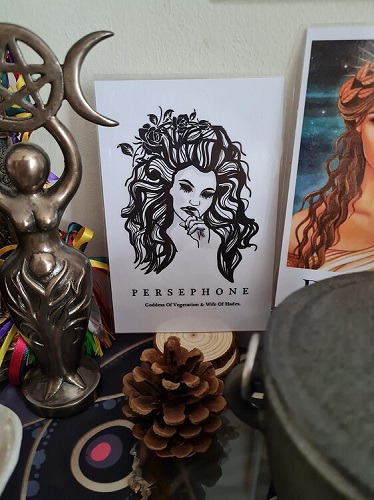
Persephone altar by Iris
Get to know Persephone through by reading her myths and poetry. Tend to a garden or keep a plant, practice herbalism, perform ritual baths in her name, go on a nature walk, pick up litter, honor the dead or visit a graveyard.
Make an offering or say a prayer. There is no right or wrong way to worship the Goddess. Always be respectful and sincere.
Celebrate her sacred days. Persephone’s holidays include:
Thesmophoria was an ancient Greek religious festival, held in honor of the goddess Demeter and her daughter Persephone. Celebrated in the autumn, this was a women-only ritual to promote fertility, both human and agricultural.
The Spring Equinox marks Persephone’s annual return from the Underworld, allowing the Earth to bloom again. The Queen of Hades travels up to Olympus to spend a season with her mother, Demeter, as the first seeds begin to sprout. This can be celebrated every year around Ostara.
The Autumn Equinox: Also known as Mabon, it is a Wiccan sabbat when some practitioners perform a special rite for the goddess Persephone’s descent into the Underworld. For as long as Demeter and her daughter Persephone are separated, the land remains barren.
Samhain: Honor your ancestors or visit a graveyard. Offer the dead some food like nuts, small cakes, fruits, and place out some coins too. Muse about your past lives with Persephone.
Strengthen your dedication and devotion to her by crafting an altar to Persephone. Here are some ideas:
Goddess Persephone Correspondences
Associations: Spring, flowers, waterfalls, rivers, torches, reeds, bats, rams, birds, lavender, lily of the valley, willow trees.
Scents: Floral, pomegranate, bergamot, almond, and vanilla.
Colors: Indigo, yellow, purple, black, and light blue.
Crystals: Jasper, black onyx, quartz, agate, sapphire, pink tourmaline, obsidian, coral.
Offerings to Persephone
Suitable offerings for Persephone include: Pomegranates, Bread, Wine, Water, Cakes, Fruits, Flower arrangements, Crowns, Bones, Dark chocolate, Seeds, Artwork.
Write some poetry inspired by her story or make a music playlist for her. Set up a bird feeder in the spring and summer. Perform your personal dedication by your Persephone’s altar.
Invocations & Prayers to Persephone
There are many beautiful ways of praying to Goddess Persephone. Here is a prayer to invite Brigid into our ritual, inspired by the Orphic Hymn to Persephone as translated by Asphodel P. Long.
Chant this prayer with a Waxing Moon 🌒 to call upon Persephone’s power of renewal and rebirth.
Spring Invocation to Persephone
“Come, Persephone,
With your paint-pots and brushes:
Stipple the fields with flowers,
Dot the branches with bright blossoms
Streak the Spring sky with pale pastels.
You are the one who paints the eyes on the pansies,
And the lines on the lilies so the bees can find their food,
And the blushes on the rosebuds.
Without you,
The bearded iris would have no smile
And the black-eyed susan would be blind.
Come, Persephone:
The world has rested too long
Under Winter’s snowy cloak.
Come bring your brushes and bright colors
And dress us in the shades of Spring again.
We invoke you, gracious maiden of freedom and beauty.
So mote it be.”
By Elizabeth Barrette
Clean away and banish the Winter with a Spring Cleansing Chant
Devotional Hymn to Hades
In ancient Greece, Hades was not considered intrinsically evil or some sort of “devil”. He was simply the ruler of the domain of the dead. Meanwile, the God of Death was Thanatos. Hades was simply a caretaker of the dead and can be seen as a representation of the balance in life. He was worshipped in times of death and offerings to him were buried in a pit. Invocations were said with palms facing down after pounding on the ground as though to gain his attention.
Hades had no festival of his own and no temples were dedicated to him. In fact, most ancient Greeks were afraid of saying his name so they’d call him by his many epithets, such as the Unseen One or the Wealthy One (Plouton).
Inspired by the Orphic hymns written in the late Hellenistic period, and voiced by Joy for Spells8, this is a humble way to connect with the Lord of the Underworld. Hymn to Hades »
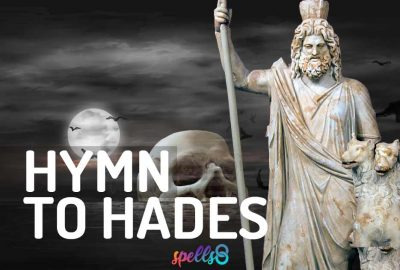
Further Reading
Persephone: Practicing the Art of Personal Power (Pagan Portals collection) by Robin Corak
Queen of the Sacred Way: A Devotional Anthology In Honor of Persephone edited by Melitta Benu
Persephone Rising: Awakening the Heroine Within by Carol S. Pearson
https://spells8.com/lessons/persephone-goddess/
1 note
·
View note